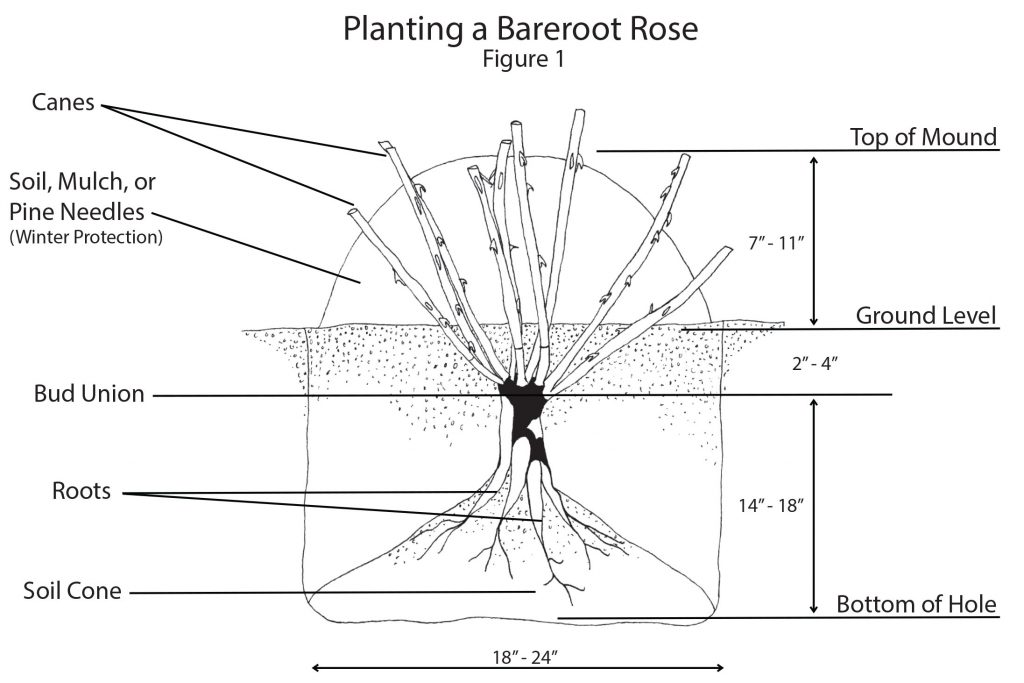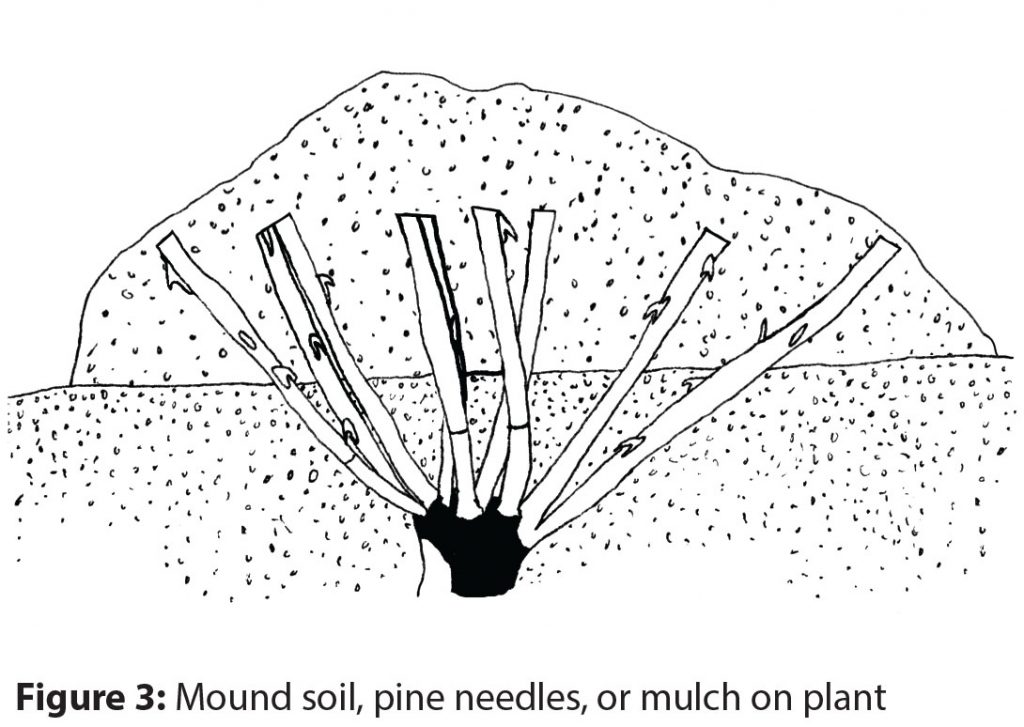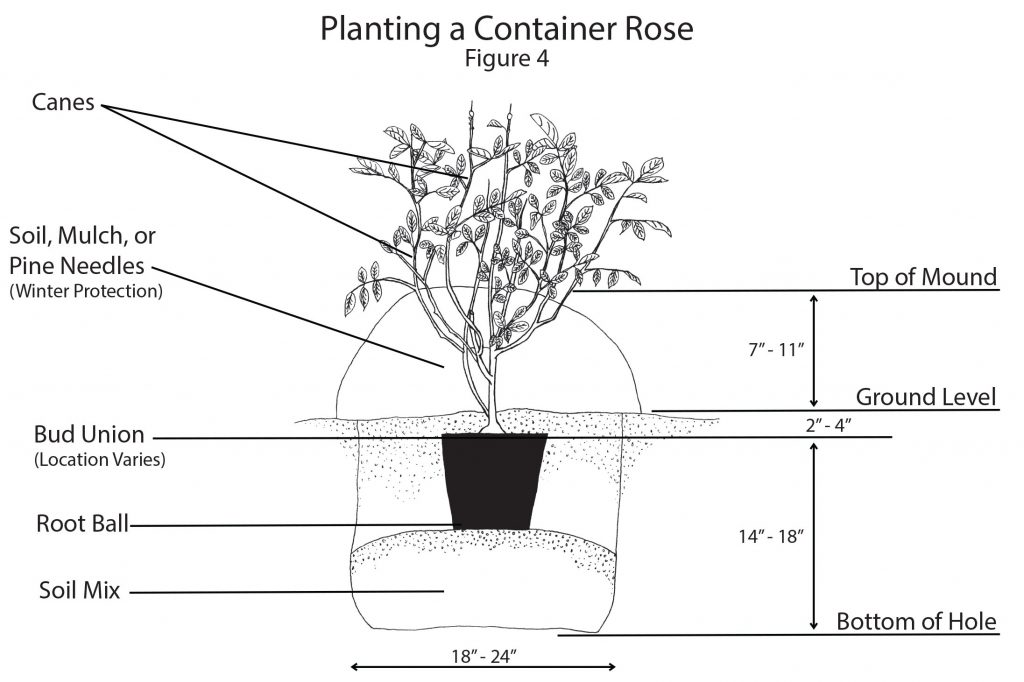by A.W. Nelson and C.E. Swift *(9/20)
Revised by Roger G. Heins & Alison Stoven O’Connor**
Quick Facts…
- Select a site in full sun or at a minimum 7 hours of sun with well-drained soil, free of competing tree and shrub roots.
- Select recommended plants from a reputable nursery or mail-order catalog and plant properly in good or improved soil.
- Plant bare-root and packaged roses in early spring and protect them by covering the entire plant with loose, loamy, moist soil, or a soil compost mix if the soil is clay, or use a mulch until the root system starts to function.
- Do not allow bare-root and packaged roses to dry out before and after planting.
- Plant budded roses so that the bud union is 3 to 4 inches below the soil line. Plant own root roses so that the crown is 2 inches below the soil line.
- If the soil is clay or clay loam, mix it with 1/3rd compost.
Roses can grow in most communities in Colorado. Colorado roses exhibit some of the most vivid colors seen anywhere in the country.
The American Rose Society lists 48 classifications for roses, but roses in Colorado can generally be said to fall into one of the following types: hybrid tea, miniature, floribunda, grandiflora, climber, shrub (which includes English and Canadian roses), polyantha and hybrid rugosa.
The hybrid tea, originally a cross between a tea rose and a hybrid perpetual, is the most popular garden rose. Generally, they produce large blooms on long stems and are preferred for exhibition and cut flowers. Miniatures are naturally dwarf roses and remain popular, especially in small garden spaces. With proper care, they are a good choice for potted indoor culture. Because of their hardiness, they are excellent for outdoor use.
The first floribunda was produced from a cross between a hybrid tea and a polyantha rose. These roses usually have smaller blooms than hybrid teas, but typically repeat blooming in clusters each season. They are somewhat hardier than grandifloras and hybrid teas.
The original grandiflora was produced from a cross between a hybrid tea and a floribunda. This plant is similar in size to the hybrid tea but usually has slightly smaller flowers and greater blooms.
The climbing hybrid teas and climbing grandifloras are generally not recommended for most areas of Colorado because most will bloom only on the previous year’s growth. During severe winters, the previous year’s growth on these climbers is damaged by cold temperatures and drying. This results in little or no bloom or blooms of poor quality the following season. There are, however, a number of repeat-blooming, large flowered climbers (LCL) that do well in Colorado’s climate. Most of these climbers will bloom on the current year’s growth (new wood) and have the added advantage of repeat flowers.
The term “shrub rose” is used loosely to cover roses not previously mentioned. Some of the hardiest of all roses can be found in this group. With its beauty, perfume and history, the shrub rose can be a satisfactory part of the landscape. Included in this group are the English Roses developed by David Austin. Canadian roses were developed under the direction of the Canadian Department of Agriculture for winter hardiness, disease resistance, ease of propagation and repeat blooming.
Hybrid rugosa roses are known for their fragrance , hardiness and sturdiness in the garden. They can be identified by their numerous thorns and dark green leaves with deep veining. The hips, left from spent blooms, are often showy in winter. These roses can perform in poor soils and drought conditions.
Selecting Plants
Roses are sold through mail-order nurseries, local garden and nursery outlets, hardware and box stores and grocery stores. Generally mail-order nurseries handle bare root, dormant roses. Local nurseries usually sell potted roses. Box stores and grocery stores may offer bare root or potted roses.
Most experienced rose growers prefer bare root, dormant plants from a reputable nursery. Potted roses are a viable choice only when the nursery has used good culture in the potting and care of the plants. Make sure bare root packaged roses are purchased before the plant has had a chance to dry out and deteriorate on the shelf.
Site Selection
Site selection is important. The best site would be an area that gets full sun with good air circulation. In windy sites, protect the roses from the prevailing wind.
A good second choice is a location that gets full sun during the early morning hours. This might be on the east side of buildings or an area that is shaded by trees in the afternoon. Locate the plants so they receive a minimum of five to six hours of sunshine. The early sunshine will dry dew off plants and help prevent diseases.
When choosing a location, avoid places where the roses have to compete with tree or shrub roots for water and nutrients. Good drainage is also a factor in site selection.
Planting Bare Root Roses
For bare root roses, spring planting is preferred over fall. It’s best to finish planting bare root roses by mid-April.
Prepare rose beds or planting holes prior to receiving the roses. If bare root and packaged plants appear dry when they are received, soak them in a bucket of water overnight. Do not leave them in water for more than 24 hours.
If planting in a previously prepared bed, dig the hole so it accommodates the root system, usually about 18-24 inches in diameter and 14-18 inches deep. If the roses are planted in soil that has not been prepared in advance, dig the hole at least that large. If the soil is compacted or needs improving, the planting hole may be as large as 36 inches in diameter and 18 inches deep (See Figure 1).

If the subsoil in the bottom of the planting hole or rose bed is heavy clay, it may be desirable to replace a portion of this subsoil with peat moss or compost. Thoroughly mix the peat moss or compost (equal in volume to no more than one-third of the kept soil) with the good soil.
Never allow the plants to dry out. Roses may be kept in a bucket of water while the hole is being prepared. When the hole is ready, prepare the plant by pruning any damaged or broken roots. Excessively long roots may be shortened, but leave 8 to 10 inches of healthy root if possible.
Support the plant by placing it on a small mound of amended soil, spreading the roots out into the planting hole. Budded roses need to be planted so that the bud union is 3 to 4 inches below ground level. Own root roses need to be planted 2 inches below ground level. Do not pack the soil around the roots. Firm with your hands or let water from the hose settle the soil. It is important to water deeply at this time, but do not puddle the soil as this tends to separate the soil components.

Because the plant was probably topped by machine, with no consideration for proper pruning, prune the canes. Make the pruning cuts at a 30 to 45 degree angle, ¼ to 3/8 inch above a bud eye, leaving about 5 to 12 inches of the cane. In order to keep the center of the plant open for better air circulation and light penetration, these cuts should usually be made to an outward facing bud eye (See Figure 2).

Next, cover the entire plant with loose, loamy, moist soil or a mix of compost and soil, or mulch. This will keep the canes from drying out while the root system is being established and will protect the plant from possible frost damage. Preventing the canes from drying out is the most important step to take when planting a bare root rose in Colorado because of the dry climate (low humidity) (See Figure 3). This cover may be left on from two to seven weeks, depending on the weather, the plant’s progress and the time of planting. Watch the progress of the plant by exposing the tips of the canes. Be careful when removing the soil from around the canes to avoid damage to the new, tender growth. Water from a garden hose may be the best way to remove this cover.
Planting Potted Roses
Potted roses can be planted during the growing season, any time after the last killing frost. If a potted rose is purchased directly from a greenhouse, then harden off the rose outdoors (leaving the rose in its container) for 3-4 days prior to planting, watering it daily. If planting late in the season, the plant should have time to become well established in its new location before the first killing frost. Prepare the planting hole much the same as for bare root roses, with the depth determined by the height of the bud union from the bottom of the container. Carefully remove the plant from the container and place it in the hole without disturbing the root ball. Make sure the bud union is planted 2-4” below ground level. Fill in around the root ball with soil. If the rose roots are pot bound, break up the root ball with your hands or gently slice the roots with a sharp knife. Not correcting circling roots can be detrimental to your rose long-term. Water newly planted roses every day for three days; then twice a week for two weeks. Then begin deep watering once a week.

Some Recommended Varieties
Table 1 lists popular rose varieties known to do well in Colorado.
| Table 1: Recommended roses for Colorado. | |
| Varieties | Color |
| Hybrid Teas | |
| Audrey Hepburn | Light Pink |
| Barbara Streisand | Mauve |
| Black Magic | Dark Red |
| Chicago Peace | Pink Blend |
| Chrysler Imperial | Dark Red |
| Crystalline | White |
| Dick Clark | Red Blend |
| Double Delight | Red Blend |
| Fragrant Cloud | Orange Red |
| Garden Party | White |
| Gemini | Pink Blend |
| Grand Dame | Rose Pink |
| Let Freedom Ring | Red |
| Marilyn Monroe | Apricot Blend |
| Mellow Yellow | Deep Yellow |
| Mister Lincoln | Dark Red |
| Moonstone | White |
| Olympiad | Medium Red |
| Peace | Yellow Blend |
| Perfect Moment | Red Blend |
| Pope John Paul II | White |
| Rio Samba | Yellow Blend |
| St. Patrick | Yellow Blend |
| Savoy Hotel | Light Pink |
| Secret | Pink Blend |
| Signature | Deep Pink |
| Sunset Celebration | Apricot Blend |
| Sunstruck | Apricot Blend |
| Timeless | Deep Pink |
| Touch of Class | Orange Pink |
| Tournament of Roses | Pink Blend |
| Veteran’s Honor | Dark Red |
| Grandifloras | |
| Arizona | Copper |
| Crimson Bouquet | Dark Red |
| Fame! | Deep Pink |
| Glowing Peace | Yellow Blend |
| Gold Medal | Medium Yellow |
| Lagerfield | Mauve |
| Queen Elizabeth | Medium Pink |
| Strike it Rich | Deep Golden |
| Floribundas | |
| Amber Queen | Apricot Blend |
| Apricot Nectar | Apricot Blend |
| Betty Boop | Red Blend |
| Bill Warriner | Orange Pink |
| Black Cherry | Deep Red |
| Chihuly | Red Blend |
| Cinco de Mayo | Russet |
| Class Act | White |
| Drop Dead Red | Red Velvet |
| Easy Going | Yellow Blend |
| Easy Does It | Orange Pink Apricot Blend |
| Edd Tide | Mauve |
| Europeana | Dark Red |
| Gruss an Aachen | Light Pink |
| Hot Cocoa | Russett |
| Ice Berg | White |
| Julia Child | Yellow Gold |
| Jump for Joy | Peachy Pink |
| Lavaglut | Dark Red |
| Livin’ Easy | Orange Blend |
| Mardi Gras | Pink Blend |
| Nearly Wild | Medium Pink |
| Playboy | Red Blend |
| Playgirl | Medium Pink |
| Purple Tiger | Purple White Stripes |
| Rainbow Sorbet | Multi; Red Yellow Pink White |
| Sally Holmes | White |
| Scentimental | Red Blend |
| Sexy Rexy | Medium Pink |
| Singin’ in the Rain | Apricot Blend |
| Sunsprite | Deep Yellow |
| Miniatures | |
| Bee’s Knees | Yellow to White; Pink Edges |
| Baby Grand | Medium Pink |
| Child’s Play | Pink Blend |
| Fairhope | Light Yellow |
| Giggles | Medium Pink |
| Gourmet Popcorn | White |
| Hot Tamale | Yellow Blend |
| Incognito | Mauve |
| Irresistible | White |
| Jean Kenneally | Apricot Blend |
| Kristen | Red Blend |
| Miss Flippins | Medium Red |
| Perrine | Orange Pink |
| Rainbow’s End | Yellow Blend |
| Ruby Baby | Red Blend |
| Ruby Ruby | Medium Red |
| Salute | Red |
| Sunsprite | Deep Yellow |
| Climbing Miniatures | |
| Candy Cane | Pink Blend |
| Hi Ho | Orange Pink |
| Little Girl | Orange Pink |
| Jeannie LaJoie | Medium Pink |
| Pink Cascade | Medium Pink |
| Rainbow’s End | Yellow Blend |
| Ruby Penchant | Mauve |
| Climbers | |
| America | Orange Pink |
| Above and Beyond | Orange Apricot |
| Don Juan | Red |
| Dynamite | Dark Red |
| Fourth of July | Red Blend |
| Golden Showers | Medium Yellow |
| Handel | Red Blend |
| John Cabot | Medium Pink |
| John Davis | Medium Red |
| Lady in Red | Red |
| New Dawn | Light Pink |
| Polka | Apricot Blend |
| Ramblin Red | Red |
| White Dawn | White |
| Zephrine Droughin | Deep Pink |
| Shrub (*Denotes polyantha rose) | |
| Alba Meidiland | White |
| Apricot | Drift Apricot |
| Ballerina | Medium Pink |
| Bonica | Medium Pink |
| Carefree Delight | Pink Blend |
| Carefree Wonder | Pink Blend |
| Dortmund | Medium Red |
| Double Knock Out | Red |
| Flower Girl | Light Pink |
| Kaleidescope | Mauve |
| Kashmir | Red |
| Knock Out | Red Blend |
| Lady Shalott | Orange Red |
| Margo Koster* | Orange Blend |
| Pink Meidiland | Pink Blend |
| Princess Alexandra of Kent | Deep Pink |
| Princess Ann | Deep Pink to Red |
| Sally Holmes | White |
| Starry Night | White |
| Sunrise Sunset | Pink Blend |
| Super Hero | Red |
| The Fairy* | Light Pink |
| English (David Austin primarily) | |
| Abraham Darby | Orange Pink |
| Ambridge Rose | Apricot Blend |
| Evelyn | Apricot Blend |
| Gertrude Jekyll | Medium Pink |
| Golden Celebration | Deep Yellow |
| Graham Thomas | Deep Yellow |
| Heritage | Light Pink |
| Mary Rose | Medium Pink |
| Othello | Medium Red |
| Pat Austin | Orange Blend |
| Sharifa Asma | Light Pink |
| The Pilgrim | Medium Yellow |
| Tradescant | Dark Red |
| Canadian Hardy | |
| Adelaide Hoodless | Deep Pink |
| Bill Reid | Apricot Blend |
| Champlain | Dark Red |
| Cuthbert Grant | Dark Red |
| Henry Hudson | White |
| Henry Kelsay | Medium Red |
| John Cabot | Medium Red |
| Morden Blush | Medium Pink |
| Morden Centennial | Medium Pink |
| Morden Sunrise | Yellow Blend |
| William Baffin | Deep Pink |
| Winnipeg Parks | Deep Pink |
| Hybrid Rugosa | |
| Hansa Medium | Red |
| Linda Campbell | Medium Red |
| Therese Bugnet | Medium Pink |
| Buck Roses | |
| Carefree Beauty | Medium Pink |
| Earth Song | Deep Pink |
| Mountain Music | Pink Blend |
| Prairie Sunrise | Apricot Blend |
| Quietness | Light Pink |
| Winter Sunset | Apricot |
*A.W. Nelson, former Rocky Mountain District and Region 8 director, American Rose Society, and Colorado State University Extension master gardener (deceased); and C.E. Swift, former Extension horticulture agent, Tri River Area, Grand Junction. **Roger G. Heins, retired Vice President, Jackson and Perkins Roses; Alison Stoven O’Connor, Extension horticulture agent, Larimer County. Drawings by Lydia Cruz. 5/96. Revised 9/20.
Colorado State University, U.S. Department of Agriculture and Colorado counties cooperating. Extension programs are available to all without discrimination. No endorsement of products mentioned is intended nor is criticism implied of products not mentioned.
Go to top of this page.





